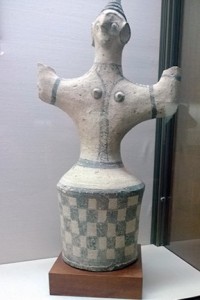I woke today to realize it was Sunday. This was extraordinarily obvious because I woke up much earlier than I planned on due to the bells calling us all to church. Rather than answering the call we all waited until a man’s chanting added ambiance to our breakfast. The chanting went on for a couple hours. Apparently after the morning service and communion was over, a funeral began. These words too were broadcasted throughout the entire town on giant speakers. I’ve never seen a church service broadcasted before, but that may be my own ignorance.
We then tried to fit all our luggage – including Caitlin’s giant bag – into the vans and headed to Rethymno. We went to the museum of Ancient Polyrrhenia, which was outside the high imposing walls of Fortetza Fortress.
 Next to the entrance was some graffiti which, when translated, read “the only good fascist is a dead one.” Appropriately charmed we entered the museum. The one open room with the works could be navigated circumambulatory in a clockwise manner, progression chronologically from the Neolithic to Roman periods. Amongst the works were such pieces like Kamares ware pottery, the first sighting of what will apparently be common.
Next to the entrance was some graffiti which, when translated, read “the only good fascist is a dead one.” Appropriately charmed we entered the museum. The one open room with the works could be navigated circumambulatory in a clockwise manner, progression chronologically from the Neolithic to Roman periods. Amongst the works were such pieces like Kamares ware pottery, the first sighting of what will apparently be common.
The as we explore a statue that is the only concrete evidence of religious life in early Minoan culture, fragments with Linear A, and statues of GUAs: Goddesses with Upraised Arms, typical of the final phase of the Cretan Bronze Age, LM IIIC. We also learned about the kernos, a ritual vase shaped like a stand with multiple vessels, and even how papyrus plants were made into paper. Most fascinating to me was an unfinished statue of Aphrodite. While unfinished, there was enough of the iconography that the subject was still pretty clear.


We then walked around Rethymno looking for some place to eat, which was an unsuccessful endeavor. The town was picturesque though, and similar to Chania in its building style.
We did get to see a mosque as well, which was being reconstructed rather than allowed to fall due to earthquakes, like many of it’s other Cretian counterparts. The minaret had scaffolding and the mosque was closed, but the exterior was in itself quite impressive.

